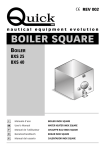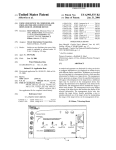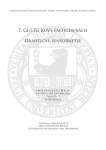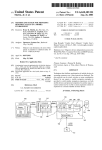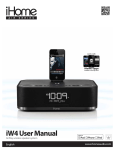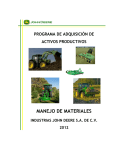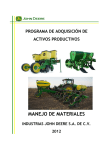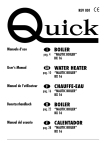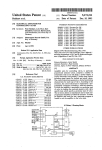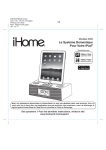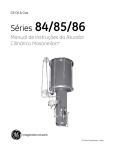Download Method and system for providing resource access in a mobile
Transcript
US006715131B2 (12) United States Patent (10) Patent N0.: (45) Date of Patent: Martin, Jr. et al. (54) (75) (56) METHOD AND SYSTEM FOR PROVIDING RESOURCE ACCESS IN A MOBILE ENVIRONMENT B1 B1 B1 B1 1/2001 1/2001 11/2001 4/2002 Beall et al. ............... .. Nakamura et al. ........ .. De Boor et al. .......... .. Gotou et al. .............. .. 707/103 715/513 709/217 701/201 FOREIGN PATENT DOCUMENTS 2 331 600 A WO 97/49044 5/1999 12/1997 OTHER PUBLICATIONS Subject to any disclaimer, the term of this patent is extended or adjusted under 35 U.S.C. 154(b) by 0 days. Bickmore et al., “Digestor: device—independent access to the World Wide Web,” Computer Networks and ISDN Systems, vol. 29, No. 8—13, Sep. 1997, pp. 1075—1082. Greg Hewgill, “Copilot User’s Manual,” Copilot User’s (21) Appl. No.: 10/458,033 Jun. 9, 2003 (22) Filed: Prior Publication Data (65) Manual Version 1.0 Beta 9, URL: www.hewgill.com/pilot/ copilot/copilothtml. Primary Examiner—Thomas M. Heckler US 2003/0214529 A1 Nov. 20, 2003 (74) Attorney, Agent, or Firm—Beyer Weaver & Thomas, LLP Related US. Application Data (62) References Cited 6,169,992 6,178,433 6,317,781 6,377,886 GB W0 (73) Assignee: Openwave Systems Inc., Redwood City, CA (US) (*) Mar. 30, 2004 U.S. PATENT DOCUMENTS Inventors: Bruce K. Martin, Jr., Palo Alto, CA (US); Arnaud P. Y. Capitant, Paris (FR); Lawrence M. Stein, San Jose, CA (US); Jonathan M. Wul?', Los Gatos, CA (US); Andrew L. Laursen, San Mateo, CA (US) Notice: US 6,715,131 B2 Division of application No. 09/575,901, ?led on May 22, 2000, now Pat. No. 6,610,105, which is a continuation-in part of application No. 09/320,296, ?led on Jun. 7, 1999, now Pat. No. 6,233,608, which is a continuation of appli cation No. 08/987,346, ?led on Dec. 9, 1997, now Pat. No. (57) ABSTRACT Techniques that facilitate participation of mobile devices in accessing resources over a data network are disclosed. The data network can be wired, wireless or some combination 6,065,120. thereof. In one aspect, a mobile navigation metaphor is (60) Provisional application No. 60/154,420, ?led on Sep. 17, provided to yield similar navigation experiences on both (51) (52) (58) Int. Cl.7 ................................................ .. G06F 3/14 central content server is able to return requested content to US. requesters in a format suitable for their device. 1999. mobile devices and personal computers. In another aspect, a Cl. . . . . . . . . . . . . . . . . . . . . . . . .. 715/526 Field of Search ............................... .. 715/526, 500, 15 Claims, 14 Drawing Sheets 715/5001; 709/208, 217_219; 707/10 Mobile Navigation Metaphor 424 Display Screen 422 1. 2v 3. 4. . Mai] . Stock . Information Mail Stock Information Address book . Address book . Directions . Remainders . Travel . Driving Markup language B Markup langmage A (HTML, XML, ...) (WML, HDML, cHTML, ...) 426 420 Menu Database Host Server U.S. Patent Mar. 30, 2004 Sheet 1 0f 14 US 6,715,131 B2 mo? w 2392 @250 ME3 DUOE M PLVOPz. 0I. ] U.S. Patent Mar. 30, 2004 Sheet 2 0f 14 US 6,715,131 B2 Fig.1B 155 O 1 158160 C)o V152 A Oooo} Q CD ) koo < 154 156 U.S. Patent Mar. 30, 2004 Sheet 3 0f 14 US 6,715,131 B2 ‘N.ME #0~\\BE S \“254% 0:9.0!i2 5~:\ H No @ HE_\ H w?\. is‘atom NSbt_Umiow\ m AlV5“®Cmo\ om_ 2 ~ 083_N21c56G \ Q7N6m2g U.S. Patent Mar. 30, 2004 Sheet 6 0f 14 US 6,715,131 B2 mm.mE o m mum own ?odcsmxz bgu3nw%o? 3N85m wmto mhBoZ $v2 k $.180m25 1 $m 5T2305 // \ 8095n,o1.52.x1 com52P380m unownewcozum Lbmuc2om wcoz m i5on:3 8Es:a9u8 2 U.S. Patent Mar. 30, 2004 Sheet 11 0f 14 US 6,715,131 B2 Ev.ME Now --_--------q---~---------c |l I 2 $8 82 § 6 > 5o68am 0mnwdE omhuwSEé-U 38d2> $3282 @m5% a?anumcwm 3o0w.“-3:. QO< ----’--_-n---—q -------—------__- U.S. Patent Mar. 30, 2004 Sheet 12 0f 14 US 6,715,131 B2 v6 .ME HOSSHDOEH WAQJE ga HWQZDEAOU MmBO MmQOU MmIQOUZY mUHO> mwéok Win02 mOT/MQ Meai/ma EIOVrRIHlNI 'IODOlOHd SSEI'IERHM mwqag MO>HWZ AHOWHW )IHOM J ZQU JEZQH .m m .EmO .UHm >~HEDU U.S. Patent Mar. 30, 2004 Sheet 13 0f 14 US 6,715,131 B2 mm.ME 'EIOVdHlNI 'IODOLOEId SSEI'IERHM MOwmU PMmT/OEm mHZ OU am UT./Mm US 6,715,131 B2 1 2 METHOD AND SYSTEM FOR PROVIDING RESOURCE ACCESS IN A MOBILE ENVIRONMENT In order to provide mobility and portable access to the World Wide Web, interactive tWo-Way communication mobile devices have been introduced that are capable of communicating, via Wireless data netWorks, With the Inter CROSS REFERENCE TO RELATED APPLICATIONS net. As an example, see US. Pat. No. 5,809,415, Which is assigned to the assignee of the present invention, and hereby incorporated by reference herein. The interactive tWo-Way This application is a Divisional application of co-pending US. patent application Ser. No. 09/575,901, entitled “Method And System for Providing Resource Access in a Mobile Environment,” ?led May 22, 2000, now US. Pat. No. 6,610,105, Which claims the bene?t of US. Provisional communication mobile devices include tWo-Way pagers, cellular phones, palm-siZed computing devices and personal 10 Application No. 60/154,420, ?led Sep. 17, 1999, entitled “Method and System for Providing a Mobile Navigation Metaphor,” and Which is a continuation-in-part of US. patent application Ser. No. 09/320,296, ?led Jun. 7, 1999, entitled “Method and System for Securely Interacting With Managed Data From Multiple Devices,” now US. Pat. No. 6,233,608, Which is a continuation of US. patent application Ser. No. 08/987,346, ?led Dec. 9, 1997, entitled “Method And Architecture For Self-Provisioning a Rendezvous To digital assistant (PDA) devices, and are among the fastest emerging communication devices. Such devices enable users to receive, collect, analyZe, revieW and disseminate information as they travel or move about. 15 In a similar manner to the portals that have been designed to assist desktop computer users to navigate on the Internet, efforts have been commenced to provide portals designed speci?cally for users of mobile devices. For example, Wire less or portable portals offered by AirFlash.com, Inc. (see WWW.air?ash.com) and Saraide, Inc. (see WWW.saraide.com) 20 are designed for access by users of mobile devices. Multiple Devices,” now US. Pat. No. 6,065,120, and HoWever, a user’s navigation experience on a display screen of a mobile device and through a typical portal assigned to the assignee of the present application, the vieWed on a computer screen are conventionally very dif Ensure Secure Access to Information In a Database From disclosures of all of Which are incorporated herein by reference for all purposes. ferent. This is primarily because of the substantial differ 25 tWo types of devices. In many cases, it is not at all intuitive hoW the links and organiZation of those links into menus in one environment are related to the presentation of those COPYRIGHT NOTICE A portion of the disclosure of this patent document contains material Which is subject to copyright protection. links and menus in the other environment. This can cause the 30 The copyright oWner has no objection to the facsimile disclosure as it appears in the US. Patent and Trademark Of?ce patent ?le or records, but otherWise reserves all 35 SUMMARY OF THE INVENTION 1. Field of the Invention puting devices and, more speci?cally, to methods and sys device based on their familiarity With the navigation process on the other device. Thus, there is therefore a need for techniques that provide users With a similar navigation experience on both mobile devices and computers (e.g., desktop computers). BACKGROUND OF THE INVENTION The present invention relates to user interfaces for com user to be confused regarding hoW they should navigate through the menu structure to get to a desired link on one reproduction by anyone of the patent document or the patent copyright rights Whatsoever. ences betWeen the user interfaces and menu structures of the 40 Broadly speaking, the invention relates to techniques to facilitate participation of mobile devices in accessing tems providing consistent user interaction With a user inter resources over a data netWork. The data netWork can be face of a Wireless portal. 2. Description of the Related Art The Internet is a rapidly groWing communication netWork Wired, Wireless or some combination thereof. In one aspect of interconnected computers and computer netWorks around the World. Together, these millions of connected computers form a repository of multimedia information that is readily accessible by any of the connected computers from any Where at any time. To facilitate the navigation of this 45 a central content server is able to return requested content to 50 repository, a number of Internet access providers offer portals to the World Wide Web for users. In a general sense, a “portal” is a door or entrance, especially a grand or imposing one. In the context of the present invention, portal is a relatively neW term for a World Wide Web site that is or proposes to be a major starting site for users When they get connected to the World Wide Web, 55 an image representation resembling the display screen of the personal computer, the image representation comprising is typically represented as a page that contains links to 60 As a computer readable medium including at least com puter program code for providing a mobile navigation metaphor in a portal for a mobile device having a display (WWW.yahoo.com) and Excite (WWW.excite.com), it has companies operating the portals and the ultimate end-users, to establish such Internet portals. contents that can be similarly displayed on the display screen of the mobile device; and generating an updated image representation Whenever the contents are updated. ing to subject matter or the type of services offered at those sites. With the commercial success of such search engines that have transformed into portals such as Yahoo! become desirable, both from the point of vieW of the requesters in a format suitable for their device. The invention can be implemented in numerous Ways including, as a system, apparatus, method and computer readable medium. Several embodiments of the invention are discussed beloW. As a method for providing a mobile navigation metaphor in a portal for a mobile device having a display screen, one embodiment of the invention includes the acts of: providing mobile device but being displayed on a display screen of a or that users tend to visit as an anchor site. Such a portal site numerous other sites, With the links being organiZed accord of the invention a mobile navigation metaphor is provided to yield similar navigation experiences on both mobile devices and personal computers. In another aspect of the invention, 65 screen, one embodiment of the invention includes: computer program code for providing an image representation resem bling the display screen of the mobile device but being US 6,715,131 B2 3 4 displayed on a display screen of a personal computer, the thorough understanding of the present invention. HoWever, image representation comprising contents that can be simi larly displayed on the display screen of the mobile device; and computer program code for generating an updated image representation Whenever the contents are updated. it should be apparent to those skilled in the art that the present invention may be practiced Without these speci?c details. The description and representation herein are the common means used by those experienced or skilled in the art to most effectively convey the substance of their Work to others skilled in the art. In some instances, Well knoWn The advantages of the invention are numerous. Different embodiments or implementations may have one or more of the folloWing advantages. One advantage of the invention is methods, procedures, components, and circuitry have not that a similar navigation experience can be had for users of been described in detail to avoid unnecessarily obscuring aspects of the present invention. The invention relates to techniques to facilitate participa both mobile devices and personal computers. Another 10 advantage of the invention is that servers can distinguish betWeen requesting device types (e.g., mobile device vs. personal computer) so that the returned content is suitable for the requesting device type. Other aspects and advantages of the invention Will become apparent from the folloWing detailed description, taken in conjunction With the accompanying draWings, illustrating by Way of example the principles of the inven tion of mobile devices in accessing resources over a data netWork. The data netWork can be Wired, Wireless or some combination thereof. In one aspect of the invention a mobile 15 In another aspect of the invention, a central content server is able to return requested content to requesters in a format suitable for their device. tion. BRIEF DESCRIPTION OF THE DRAWINGS The present invention Will be readily understood by the folloWing detailed description in conjunction With the accompanying draWings, Wherein like reference numerals designate like structural elements, and in Which: FIG. 1A shoWs exemplary system con?guration in Which 25 Referring to the draWings, in Which like numerals refer to like parts throughout the several vieWs, FIGS. 1A—6 are discussed in detail beloW. FIG. 1A illustrates an exemplary system con?guration in Which the present invention may be practiced. Landnet 100 is a landline netWork (Wired netWork) that may be the Internet, the Intranet or a data netWork formed from a set of private netWorks. Airnet 102 the present invention may be practiced; FIG. 1B depicts a mobile device (e.g., a digital cellular phone) that can be used in the exemplary system con?gu ration of FIG. 1A; is a Wireless data netWork. Coupled to landnet 100 are a personal computer (PC) 110 representing one of the many computers coupled to landnet 100 and a plurality of netWork servers 104 (identi?ed as elements 104-1, 104-2, . . . , 104-m in the ?gure). Preferably, personal computer 110 runs a FIG. 2A shoWs an architecture based on the exemplary HyperText Markup Language (HTML) broWser, such as Netscape Navigator from Netscape Communications Cor system con?guration of FIG. 1A; FIG. 2B shoWs a user account associated With a mobile device serviced by the exemplary system con?guration of FIG. 1A; navigation metaphor is provided to yield similar navigation experiences on both mobile devices and personal computers. poration (WWW.netscape.com). The HTML broWser accesses 35 information stored in netWork servers 104 via landnet 100 using HyperText Transfer Protocol (HTTP). The netWork FIG. 3A shoWs an exemplary portal page according to one servers 104 may be Workstations or desktop computers. The information stored in netWork servers 104 may be various media or hypermedia information and may include video embodiment of the invention; FIG. 3B illustrates a screen display for a mobile device according to the mobile navigation metaphor of FIG. 3A; footage, audio clips, text, hyperlinks, and various applica FIG. 4A shoWs a matching table used to synchroniZe user interfaces betWeen tWo different broWsers; FIG. 4B shoWs a menu generation system in Which a tions. When netWork servers 104 provide information for mobile devices, the information may include mobile data designed for mobile devices. The mobile data may be expressed in a format that is more appropriate for transport over a Wireless netWork and for presentation (i.e., display) single database service is used in creating different user interfaces depending on the broWser type; 45 FIG. 4C shoWs a How diagram in Which a request is received and parsed to access appropriate data, applications, on a screen of the mobile devices. In such cases, the mobile and services in a host server; data may be communicated over the Wireless netWork using a different protocol than that used for data transmitted over FIG. 4D shoWs a second exemplary portal page according to one embodiment of the invention after the “stock” link in the mobile navigation metaphor With respect to the ?rst exemplary portal page is activated; FIG. 4E illustrates a screen display for a mobile device according to the mobile navigation metaphor of FIG. 4D; 55 FIG. 5A illustrates a block diagram of a mobile device according to one embodiment of the present invention; FIG. 5B illustrates a block diagram of a host server a Wired netWork (e.g., the landnet). For example, the Wired netWork might use HTTP and HTML protocols and the Wireless netWork might use HTTP and HDML protocols. Mobile device 106 represents one of many mobile devices serviced by airnet 102. Typically mobile device 106 is an interactive tWo-Way communication device that includes, but is not limited to, a mobile computing device, a Wireless telephone, a palm-siZed computing device, a PDA, or an Internet-capable appliance remote controller. Mobile device 106 is capable of communicating Wirelessly With antenna according to one embodiment of the pint invention; and FIG. 6 shoWs a process ?oWchart for the host server of In the folloWing description of the present invention, 108 via airnet 102. For simplicity, antenna 108 also represents a Wireless carrier infrastructure that generally comprises a base station and an operations and maintenance center. The base station controls radio or telecommunication links With mobile device 106. The operations and maintenance center com numerous speci?c details are set forth in order to provide a prises a mobile sWitching center performing the sWitching of FIG. 5B according to one embodiment of the present inven tion. DETAILED DESCRIPTION OF THE INVENTION 65 US 6,715,131 B2 5 6 calls between the mobile devices and other ?xed or mobile network users. The operations and maintenance center man ages mobile account services, such as authentication, and oversees the proper operation and setup of the Wireless netWork. Each of the hardWare components and processes in carrier infrastructure 108 are knoWn to those skilled in the art and are not described herein to avoid unnecessarily factured by OpenWave Systems Inc., RedWood City, Calif., the assignee of the present invention. The micro-broWser Works ef?ciently When used to display a markup language ?le speci?cally designed for use With the portable device. Examples of such markup languages include HDML and WML. Referring noW to FIG. 2A, there is depicted a system architecture based on the exemplary system con?guration of FIG. 1A. As described above, the airnet 102 communicates simultaneously With a plurality of mobile devices 106 obscuring aspects of the present invention. BetWeen landnet 100 and airnet 102 there is a server device 114 functioning as a bridge betWeen the tWo net Works 100 and 102. Server 114, also referred to as a link (shoWn as devices 106-1, 106-2, . . . 106-n in the ?gure). A PC 110 represents one of the computers that use the HTML broWser running on HTTP to access other computers/servers 132 or 134 to fetch information on line or simply copy ?les server, proxy server, Wireless data server or netWork gate Way server, may be a Workstation or a personal computer. Link server 114 couples airnet 102 to landnet 100 to facili tate the communication betWeen the tWo netWorks. It should 15 be noted that server 114 may be of the same type as one of therefrom. When employing the present invention, PC 110 can be used to pre-enter or organiZe the frequent transactions desired by a user of a mobile device through use of a larger user interface and easier user input. It is generally understood that a database or an allocation of memory, as referenced by 130 in FIG. 2A, hosts a servers 104, except that it implements an embodiment of the present invention. In other Words, any one of servers 104 may function as a proxy server. To facilitate the description of the present invention, FIG. plurality of user accounts, each designated to an authoriZed 1B depicts a cellular phone 150 that can be used as one of capacity in Which managed or personaliZed information is the mobile devices 106 in the exemplary system con?gura kept. The information stored in the user accounts can be used tion of FIG. 1A. Cellular phone 150 includes a small screen to provide a mobile navigation metaphor in a portal asso 152 and an extended phone keypad 154. Screen 152 is typically a LCD display. Extended phone keypad 154 comprises, preferably, a regular phone keypad 155, a pair of generic keys 158 and 160 and positioning key 156. Generic ciated With mobile devices and PCs. Database 130 can be an 25 a portal from a computer on landnet 104 or through a mobile device, the user needs ?rst to be authenticated to enable keys 158 and 160 are used to activate soft keys displayed in screen 152, and positioning key 156 is used to reposition an access to a respective user account in the host server 128 or database 130. This is typically accomplished through use of a username/passWord pair or an assigned ticket (code). Due to the reduced siZe, Weight and cost of mobile devices as compared to desktop computers, most of the element indicator or a cursor to activate a desired function (e. g., activate one of the hyperlinks displayed in screen 152). It should be understood that generic keys 158 and 160 and positioning key 156 are not necessary in practicing the present invention and can be replaced by a set of designated keys in regular phone keypad 155. Generic keys 158 and 160 mobile devices also have very limited computing resources 35 provide a convenient means for a user to interact ef?ciently telephone, have a keypad having far feWer keys or buttons than a PC keyboard has, Which makes data entry laborious. For example, a user requesting information on Stanford University using InfoseekTM as the search engine, Would have to input the folloWing string: WWW.infoseek.com folloWed by “Stanford University” devices that use soft keys or icons as an input means for users to interact With the devices. In the folloWing, unless otherWise speci?cally described, keys or buttons are gener The string listed above includes over 40 characters. Auser 45 Would have no problem. HoWever, the same user operating a keypad of a Wireless device to input the string Would be information in a server (e.g., server 104). HoWever, HTTP requires considerable computing poWer and netWork band severely limited in terms of the speed of data entry due to the small number of available keys and the close spacing betWeen them. Some transactions frequently desired by a user of such mobile devices may be predetermined or pre-entered in a Width resources. For example, a request from the computer to establish a communication session With a netWork server computer, including personal computers and Workstations coupled to a netWork operating HTTP, generally has suf? cient computing poWer, memory and display capabilities. The computing resources available in cellular phone 150 inputting a string of this type using a PC keyboard and broWser (e.g., Netscape Navigator or Microsoft Explorer) an HTML broWser using HTTP can access hypermedia may require an exchange of a number of data packets. In addition to the resources required to implement HTTP, signi?cant resources must be supported in the computer to request, format, process and display information. This is not a signi?cant disadvantage in many situations because the compared to such computers. Moreover, the graphics capa bilities of the display screens of the mobile devices are also limited. Some of the mobile devices, such as a Wireless With the phone 150. Further, it should be understood that having a regular phone keypad is not a requirement to practice the present invention. Some of the mobile devices Which may be used With the present invention may have feW or no physical keys at all, such as those palm-siZe computing ally referred to as either the physical keys or soft keys. It is generally understood that a computer equipped With independent storage location or physically a part of host server 128. To access the personaliZed information through 55 corresponding user account maintained in a host server 128 or link server 114, so that the user need only select desired transactions folloWed by a feW letters. For example, if there is a list of stock symbols of interest in a user account that is associated With the user’s mobile phone, a user of the mobile phone Will not have to key in the symbols every time he desires to look up the current trading price of those stocks. Instead, the list of stock symbols can be previously entered of FIG. 1B or mobile devices 106 of FIG. 1A are typically and associated With the user account. When the phone user much less than What is found in a personal computer. To enable such a mobile device to communicate ef?ciently With accesses an application program providing stock price a data netWork, a micro-broWser requiring less memory and information, the list of stock symbols and their correspond con?gured to execute in a portable device may be used. An 65 ing prices can be automatically retrieved. FIG. 2B shoWs a user account associated With mobile example of a micro-broWser Well-suited to operate in a mobile communication device is one designed and manu device 106 according to one embodiment. Typically, each US 6,715,131 B2 7 8 mobile device serviced by a carrier (responsible for host mobile device navigation screen, it is not required to be an identical or near identical replication. Instead, the mobile server 128) is assigned a device ID 140 Which can be a phone number of the device, or a combination of an IP navigation metaphor 302 should provide a suf?ciently simi lar impression to a user of the mobile device. In other Words, address and a port number, for example: 204.163.165.132101905, Where 204.163.165.132 is the IP address and 01905 is the port number. The device ID 140 is further associated With a subscriber number (sub #) 142 the image representation associated With the mobile navi gation metaphor 302 re?ects enough of the details of What is depicted on the display screen of the mobile device so that a user is provided With a similar navigation experience authoriZed by the carrier in link server 114 as part of the procedures to activate the phone 106. The sub # may take the form, for example, of 861234567-10900ipn.mobile.att.net 10 by AT&T Wireless Service and is a unique identi?cation to device 106. Each of the mobile devices 106 has a unique device ID that corresponds to a user account in a server (e.g., regardless of Whether using the PC or the mobile device. Thus, depending on the actual implementation, the contents displayed in the mobile navigation metaphor 302 may or may not be identical but, in any case, substantially close to What is displayed on the display screen of the mobile device. Hence, the mobile navigation metaphor for a Wireless portal alloWs a user to obtain a similar navigation experience link server 114 or host server 128). It may be appreciated by those skilled in the art that the link server 114 does not have 15 on a PC as on a mobile device. The similarity of the to be a separate server and can be a part of host server 128. navigation experience Will enable a user to better understand More generally, the user account associated With the the menu structure of both the PC and mobile device mobile device 106 can be determined by user identity. The interfaces, and to more efficiently navigate to a desired above-described use of subscriber numbers is one approach source of information by reinforcing the navigation experi to determining the user identi?cations and thus the user 20 ence using tWo different devices. In other Words, a user Will experience a navigation process on one device that rein accounts. Other approaches can, for example, use user forces that learned or experienced on the other device. name/passWord authentication, a portal-speci?c security model using cookies (e.g., HTTP cookies), or Secure Sock ets Layer (SSL) client-side certi?cates. According to one embodiment of the present invention, a corresponding account 144 in database 130 is indexed by an account structure 143 comprising the sub # 142, user infor mation 146, code information 148, and feature information 150. The sub # 142 is received from link server 114 as an index to the account structure 143. User information 146 25 device ID 140 and the sub # 142 may be used as the authentication code that Will alloW mobile device 106 to pass through account entry 124. In other implementations, 30 comprises the account con?guration and other account related information. Code information 148 includes creden tial information to control entry to account 144 in the database 130. From the data netWork perspective, any com puter can log on through HTTP to an account entry 152 identi?ed by an address identi?er (Which may take the form metaphor 302 illustrated in FIG. 3A. As used herein, a display screen is the physical display apparatus in a device, 35 FIG. 3B illustrates a representative screen display 322 of the mobile device. Note that the screen display 322 Was represented by the mobile navigation metaphor 302 of FIG. As shoWn in the ?gure, the PC 110 may attempt to 40 account 144 in the database 130 associated With the PC 110 (namely, the user’s account), the PC 110 can provide a code 3A. Display screen 320 is typically a LCD With limited display area. Note that the entire menu structure established 45 143, then the access requested by the PC 110 is alloWed, otherWise, the entry to the account 144 may be denied. Upon completion of the authentication process, the user of PC 110 is typically presented With a portal page that comprises a plurality of hyperlinks to desired or frequently such as a Liquid Crystal Display (LCD) screen. A screen display is the image presented on the display screen. locator (URL), for example, WWW.xyZ.com). or passWord to the host server 128, Which then can perform a veri?cation of that code or passWord based on information contained in account structure 143. If the supplied con? dential code or passWord matches that in account structure authentication or user identi?cation can be achieved using user name/passWord, cookies or certi?cates. Once the user of mobile device 106 is authenticated, the user is presented With a screen display that resembles the mobile navigation of a universal resource identi?er (URI) or universal resource establish access to account entry 152. HoWever, to access the With respect to the mobile device interfaces, When mobile device 106 accesses the Wireless portal, it Will be prompted for authentication code information. In one implementation, by a user may exceed the display capabilities of the screen of the mobile device. In such cases, screen display 322 can be scrolled up or doWn by use of a scrolling key. Screen display 322 or display screen 320 also includes an “OK” button 324 and a “Menu” button 326. Screen display 322 is a menu structure comprising a list of hyperlinks. In the example shoWn in FIG. 3B, the list includes nine (9) items, each item is a descriptive hyperlink 50 representing a category of content. Due to the limited siZe of the display screen 320, only the ?rst ?ve (5) items of the list visited sites, along With other personaliZed information. The hyperlinks may be organiZed according to categories based initially appear on the screen display 322. HoWever, a remaining portion 328 of the list includes four (4) items on subject matter, type of service offered, or another crite rion established by the user. The personaliZed information Which can subsequently appear on the screen display 322 55 folloWing scrolling actions. If a user clicks or activates one may take the form of contact or informative information or of the hyperlinks, the user Will be taken to the same or nearly a user speci?ed hierarchy of links to desired data. the same content (e.g., page) or application he/she Would be In accordance With one embodiment of the present able to access using the same category in the mobile invention, FIG. 3A shoWs a portal page 300 that comprises a mobile navigation metaphor 302. In this embodiment, the 60 mobile navigation metaphor 302 is an image representation of a display screen of a mobile device. The portal page 300 also includes frequently visited hyperlinks, graphics, texts and other personaliZed information. The portal page 300 is displayed on the display screen of the PC. It should be noted that although the mobile navigation metaphor 302 is shoWn in FIG. 3A as a replication of a navigation metaphor present on the screen display of the desktop computer. The content or application may vary to make it appropriate for the device (e.g., mobile device or desktop computer). In one embodiment, a shared database service can be used to create a different user interface for the 65 mobile or desktop device depending on the device type and characteristics of the softWare in the device responsible for producing the interface displays (e.g., the broWser type in each device). US 6,715,131 B2 10 same structure or even features as a corresponding one cation 402, then the appropriate HTML broWser link or WML broWser link Would be selected from the table depend ing on the type of broWser in use. The URL matching table designed for use by or presentation on a PC. This may be 400 includes examples for three different applications 402. Typically, an application, service or set of data designed for presentation and use on a mobile device may not have the expressed by saying that each application, service, etc. has For a home page application, the mapped URL can be the a “dual” nature. By this term is meant that each such same. The mapped URL directs the user to the home page of application or service designed for use by a mobile device a Wireless portal regardless of broWser type. For a mail application, the mapped URL can be directed to different has a corresponding application or service designed for use on a PC, and that the tWo corresponding applications and servers (i.e., mail servers) that provide the same content services may not be identical in form or implementation. (e.g., same email contents). In this case, the applications This is because there are situations in Which certain features being mapped to are for mail services but different servers are used because of the different implementations used by or functions of an application or service may be useful and the different devices. For a stock application, the mapped supportable on one type of device, but not on the other. URL can be directed to a common server but an indication Furthermore, even if the same feature or function is imple mented on both types of devices, the manner in Which the 15 (e.g., “HTML” or “WML”) can be provided to inform the server of the broWser type so that the content returned to feature or function is executed, or the manner in Which the result of the feature or function is displayed, may differ requesting devices is suitable for display on the requesting devices. betWeen the tWo types of devices. This situation of “dual” applications and services means FIG. 4B shoWs a host server 420 for use in creating different user interfaces depending on the type of broWser and/or device according to one embodiment of the inven tion. The host server 420 can be used to cause changes made that it is important that When a menu item is activated on the mobile device, the proper application or service for that class of device (e.g., mobile device) is accessed. Similarly, for the desktop computer or PC, it is important that When a menu item is activated the corresponding application or service for to a mobile device screen display 422 Which displays a menu structure on the PC in the form of a mobile navigation that class of device (e.g., PC) is accessed. Therefore, it is 25 metaphor 424. The host server 420 may also be used to cause important that When a menu item on the inventive mobile changes made to the PC menu structure to be displayed on the mobile device screen display 422 and on the mobile navigation metaphor is accessed from the PC, the PC appropriate application or service is accessed. navigation metaphor 424 (this function may occur automati cally or by execution of a “metaphor update” function). According to one embodiment, the PC side executes an HTML broWser While the mobile device executes a WML or For example, a user may edit a list of choices on the HDML broWser. The mobile navigation metaphor can also mobile device using a WML broWser. Upon an activation of a “SEND” key, the edited list is sent to the host server 420 include personaliZed information including hyperlinks to frequently visited applications and displays. Also, Whenever that operates a menu generation process in conjunction With the menu structure of the mobile device is changed, the mobile navigation metaphor can be updated so that it is continues to be representative of the menu structure of the mobile device. device information stored in a menu database 426. The menu 35 generation process produces an appropriate menu for the requesting device based on the device information. The device information can, for example, include one or more of: To ensure that both the PC and the mobile device access device characteristics, rendering context for the menu, user identity and/or broWser type utiliZed by the requesting the appropriate application or service, a URL mapping function can be performed. Note that the mobile navigation device. The generation of the menu (list) for the mobile naviga metaphor can display a menu structure having links to the mobile device appropriate applications or services or to the PC appropriate applications or services. In the case that the tion metaphor alloWs the user to access the PC side appli metaphor hyperlinks are for the mobile device side appli For example, a user updates a menu on the mobile device cations or displays, When one of the hyperlinks in the mobile cations from a menu structure de?ned on a mobile device. 45 and the updated menu in WML is sent to the host server 420. navigation metaphor is activated, a request including a URL Here the updated menu is converted to a neW menu in is generated to cause the host server to look up a URL HTML that can be displayed in the mobile navigation metaphor on the PC device. The HTML compatible links accessible by the HTML menu of the mobile navigation metaphor permit a mobile device user to navigate to the PC side appropriate applications or services via the mobile navigation metaphor on the PC device using the menu corresponding to the same hyperlink for the PC. This is accomplished by the URL mapping function. Referring to FIG. 4A, there is shoWn a URL matching table 400 suitable for synchroniZing user interfaces betWeen the tWo broWsers or devices by implementing a mapping function. A portal is hosted in a server identi?ed by an address such as my.phone.com. According to one embodiment, the mobile navigation metaphor on the portal structure of the mobile device. Conversely, When a user updates a menu in the mobile navigation metaphor, the host 55 page accessible by a PC includes a list of applications 402, server 420 updates the menu for the mobile device. Furthermore, When a user alters the menu structure (e.g., by adding or deleting bookmarks, etc.) on the PC side, the mobile navigation metaphor is also updated to re?ect those With each identi?ed by an address identi?er that serves as a hyperlink. In the URL matching table 400, each of the address identi?ers for the HTML broWser 404 corresponds changes. Thus, if the hyperlinks in the mobile navigation metaphor for the applications 402 correspond to those appropriate for Regarding the URL mapping, there are several situations in Which the corresponding URLs may be looked up in a different manner. As far as a mobile portal is concerned, both the mobile device then, When such a hyperlink is activated at the PC device, the corresponding hyperlink for the PC device broWser (e. g., HTML broWser 404) Would instead be selected from the table and activated. Similarly, if the hyperlink is a more general reference to a particular appli database 426. FIG. 4C shoWs that a request is received 440 in the host server 420. The request can be sent to the host server 420 from either the PC side or the mobile device. Since the request can comprise indication information about to an address identi?er for HDML or WML broWser 406. a PC and a mobile device can access the same menu 65























